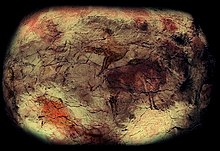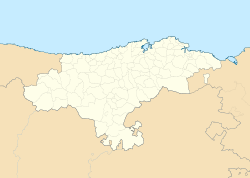Cave of Altamira
| Cave of Altamira and Paleolithic Cave Art of Northern Spain | |
|---|---|
| Name as inscribed on the World Heritage List | |

Replica at Museo Arqueológico Nacional of Cave of Altamira
|
|
| Location | Spain |
| Type | Cultural |
| Criteria | i, iii |
| Reference | 310 |
| UNESCO region | Europe and North America |
| Coordinates | 43°22′57″N 4°6′58″W / 43.38250°N 4.11611°WCoordinates: 43°22′57″N 4°6′58″W / 43.38250°N 4.11611°W |
| Inscription history | |
| Inscription | 1985 (9th Session) |
| Extensions | 2008 |
The Cave of Altamira (Spanish: Cueva de Altamira; pronounced: [ˈku̯e.βa ðe al.ta.ˈmi.ɾa]) located near the historic town Santillana del Mar in Cantabria, Spain, is renowned for its numerous parietal cave paintings featuring charcoal drawings and polychrome paintings of contemporary local fauna and human hands, created between 18,500 and 14,000 years ago during the Upper Paleolithic by Paleo human settlers. The earliest paintings in the cave were executed around 35,600 years ago.
Altamira was the first European cave for which prehistoric origin of the paintings was suggested and promoted by Marcelino Sanz de Sautuola. He published his research with the support of Juan Vilanova y Piera in 1880 to public acclaim. Nonetheless a bitter public controversy among experts ensued and continued until 1902, as reports of similar findings of prehistoric paintings in the region had accumulated and evidence could no longer be rejected.
Altamira is located in the Franco-Cantabrian region and declared a World Heritage Site by UNESCO as the central element of the Cave of Altamira and Paleolithic Cave Art of Northern Spain.
The cave is approximately 1000 meters long and consists of a series of twisting passages and chambers. The main passage varies from two to six meters in height. The cave was formed through collapses following early Karst phenomena in the calcareous rock of Mount Vispieres.
Archaeological excavations in the cave floor found rich deposits of artifacts from the Upper Solutrean (c. 18,500 years ago) and Lower Magdalenian (between c. 16,500 and 14,000 years ago). Both periods belong to the Paleolithic or Old Stone Age. In the millennia between these two occupations, the cave was evidently inhabited only by wild animals. Human occupants of the site were well-positioned to take advantage of the rich wildlife that grazed in the valleys of the surrounding mountains as well as the marine life available in nearby coastal areas. Around 13,000 years ago a rockfall sealed the cave's entrance, preserving its contents until its eventual discovery, which occurred after a nearby tree fell and disturbed the fallen rocks.
...
Wikipedia

